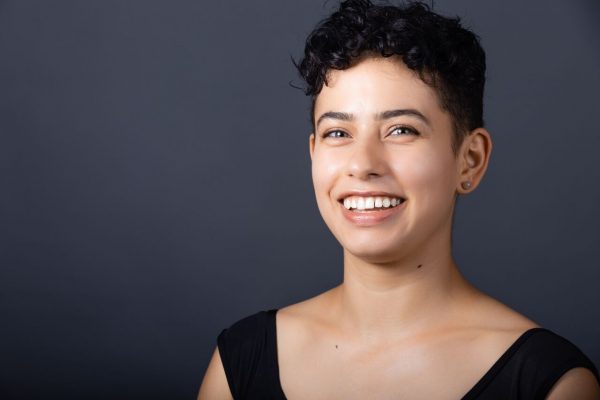CHICAGO — This post is part of a series of conversations with other trans/genderqueer dancers to give you a broader idea of where we come from, what we’re up to, and how we navigate the dance community. That said, meet Ashaand Simone!
Ashaand grew up training with Pacific Northwest Ballet and Spectrum Dance Theater in Seattle. After graduating high school, they moved to Chicago to study theater at North Park University. At North Park, Ashaand found a theater community that had a more person-centered focus, rather than the body-centric world of classical ballet. In this queer-friendly setting and with the support of a queer friend at school, Ashaand began to explore the possibility of identifying outside of the gender binary. When I asked them to describe their gender identity, they said:
“I have never felt connected to either gender, I’ve felt connected to masculine and feminine energies in different amounts on different days… I’m not interested in defining myself in any sort of way because I feel like putting myself into a box doesn’t help me understand myself, it just feels like I’m limiting myself. So I identify as non-binary, or gender non-conforming, or whatever word you want to apply to that. My favorite pronouns are they/them, my next favorite are he/him and then she/her pulls up the rear. Not because I don’t identify with she/her, just because it’s held me back.”
We also talked briefly about Ashaand’s relationship to the word “transgender” because for some folks, claiming that word and identifying with it is complicated. Ashaand considers themself “part of the trans fam,” which is to say they identify under the transgender umbrella, but connect more strongly with the identities “genderqueer” or “non-binary” than they do with “transgender.”
During their time at North Park, Ashaand began taking dance classes throughout the city and worked with Mandala South Asian Performing Arts. By happenstance and a short commute, they ended up at Joel Hall Dance Center and fell in love with Joel’s studio and company. From there they entered the work study program, auditioned for the company, performed in Nuts and Bolts and continues to dance with the company today! They are also the assistant to the studio manager and the adult scholarship program rehearsal director.
Ashaand is full of ideas about how we can transform our community to be more inclusive, starting with a more gender neutral approach to teaching our young dancers. Ashaand teaches ballet at Joel Hall and Chicago Ballet Center. Students in Ashaand’s class choose between a leotard, skirt and tights, or close fit pants and a shirt regardless of their gender assigned at birth. The same goes for costumes. Ashaand doesn’t teach separate men and women’s variations, and students of all genders are welcome to explore every aspect of ballet technique. Ashaand hopes that by training the next generation of dancers in a gender neutral way there will be more creative possibilities for ballet in the future.
“Can you imagine if all of our ballet companies had women who would jump as high as the men, and men who could move as gracefully as the women and everybody could do everything?” they asked. “The options become endless, and that’s so exciting to me.”
Something that really surprised me about Ashaand’s teaching is that despite being in such a gendered field, Ashaand uses they/them pronouns while in class. Their students address them using the honorific Mx. (pronounced “Mix”) as a gender neutral alterative to Mr. or Miss. The administration at Chicago Ballet Center even sent out information for students and parents to familiarize them with what may be new pronouns and prefixes. This has had a profound impact on some of Ashaand’s students who are starting to rethink their image of what a professional dancer can look like. One young student was inspired to finally chop her hair off because until now she thought dancers could only have long hair. I really admire the safe space Ashaand has created here and am excited for the kids who are getting such a different perspective of the dance world than most dancers get during their training.
In addition to their teaching, training, and performing, Ashaand runs Spirit Not Body and is spearheading the Raising our Standards project. Spirit Not Body is dancewear and active wear with a dancer’s pronouns embroidered on them. Ashaand says this helps teachers and students remember to use a dancer’s pronouns in class, “if you’re gonna be body based, which dance class usually is, when you look at my body I’m going to force you to look at my pronouns as well.” And it worked! Spirit Not Body’s customers report teachers finally getting their pronouns correct in class, which is a big deal for anyone, but especially someone who is constantly misgendered.
Raising Our Standards was inspired by the Chicago Theater Standards that emerged from the #NotInOurHouse movement. It aims to create a set of standards that companies can adopt ranging from auditioning practices to implementing stronger emotional, metal, and physical health support of all dancers and dance makers. Ashaand says, “Anything that a head of a company does to make their artists feel safe and supported is going to produce better art. Because when you are safe in a space, you are free to express more fully from a place of truth.”
Raising Our Standards has already held one of two introductory meetings, open to everyone in the dance community to begin forming these standards. There is a second introductory meeting coming up on April 26th from 3-6 p.m. at the Chicago Cultural Center as part of See Chicago Dance’s Chicago Dance Month programing. All are invited.
—
Spirit Not Body is on Instagram @spirit.not.body. Raising Our Standards is meeting April 26, 3-6 p.m. at the Chicago Cultural Center, 78 E. Washington St. For more information, visit their event page on See Chicago Dance. For additional questions about Spirit Not Body and Raising Our Standards, email Ashaand at simoneashaand@gmail.com.

